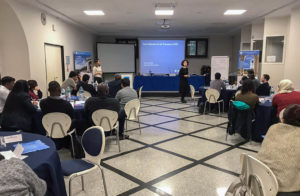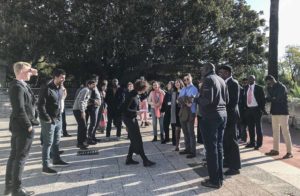To celebrate the 10th anniversary of the Kampala Convention and respond to an increasing demand from Francophone countries, the Sanremo Course on the Law of Internal Displacement for the first time was conducted in French, in addition to its well-established English edition. At JIPS we were delighted to contribute for the 4th consecutive time, by co-facilitating the sessions on data collection and durable solutions for internally displaced people (IDPs) together with the Special Rapporteur’s mandate, UNHCR and the Global Protection Cluster (GPC).
The annual training is co-organised by the International Institute of Humanitarian Law (IIHL), the Special Rapporteur on the human rights of Internally Displaced Persons (IDPs), the Swiss Federal Department of Foreign Affairs, and UNHCR. We have been involved in the Sanremo course since 2015 (see our articles from 2018 and 2017), and it continues to be a highly rewarding event for us. In fact, with more than 50 participants coming from almost 30 different countries and diverse actors – government, civil society and international organisations, academia, as well as lawyers – the course offered a unique opportunity and space for rich exchanges and learning across contexts.
Not all participants had previously been directly involved in data collection processes on IDPs, but all were eager to learn and gain a general understanding of the different data collection methods typically used in displacement contexts and the kind of information the various data sources can provide. Interestingly, although displacement contexts and participants’ profiles and experiences were very diverse, the key data challenges were similar across the board.
The topics that proved most controversial were linked to the ‘ideal’ data collection approach in internal displacement settings, the use of IDP registrations, and durable solutions beyond pure physical movement. Here is our take on these topics:

Natalia Krynsky Baal and Devora Levakova (JIPS) kicking off the session on data collection as part of the IIHL Annual Course on the Law of Internal Displacement, in November 2019. © Martina Caterina
For us, there is no “best” data collection approach, i.e. no one-size-fits-all solution. Instead, the starting point for any data collection effort should always be the specific data needs of stakeholders in a given displacement context and data landscape. In profiling exercises, for instance, we would typically first work with partners on clarifying their shared data needs and support them to agree on the objectives of the exercise.
Similarly, to effectively respond to internal displacement and find solutions, collective humanitarian and development action is needed whereby multiple stakeholders – government actors, humanitarian and development agencies, civil society as well as displacement-affected communities – work together towards IDP policies, programming, advocacy and solutions. As participants pointed out, in some cases these actors may have diverging agendas and objectives, so bringing them to collaborate throughout a data collection process may not be an easy task, but offers an opportunity to open dialogue and match information needs.
“The explanations […] provided me with new perspectives on the implementation of strategies to protect IDPs in my country.”
Comment from a participant (translated from French)
Although broadly familiar with the different existing data collection approaches, participants also highlighted their need to get a more nuanced understanding of the differences between the various types of data and what they can tell us about a displacement situation. For instance, IDP registration may be useful for targeted assistance to individuals and monitoring over time, but may not provide adequate information for long-term development planning. However, it may not be possible in every displacement situation (e.g. difficult in urban areas, where IDPs live among local communities) and creates an “IDP status”. Household surveys, in turn, can be tailored so to provide the needed evidence base for a comprehensive analysis of a displacement situation and to inform solutions. In profiling exercises, we typically opt for a mixed methods approach, combining quantitative data collection methods (e.g. household surveys) with qualitative approaches (e.g. key informant interviews, focus group discussions, etc.) (check out this JET guidance for more on the mixed methods approach).
Instead of confronting participants with dry theory, we decided to kick-start the session on durable solutions with an interactive exercise called “voting with your feet”. Participants were presented with a set of statements derived from the IASC Framework on Durable Solutions for IDPs and then asked to move left or right, depending on whether they agreed with the statement or not.

During the exercise “Vote with your Feet”, participants were asked to vote on specific questions linked to durable solutions for IDPs, by moving to one or the other side. IIHL Course on the Law of Internal Displacement in November 2019. © Martina Caterina
One statement proved particularly controversial and generated substantial discussion, which was the following:
“IDPs should no longer be considered IDPs after they have returned home.”
It was only once we deepened the conversation by looking at participants’ experiences from different contexts and common points in all of them, that the discussion became more nuanced. Participants acknowledged the fact that pure physical movement – such as an IDP returning to his or her place of habitual residence – in and by itself doesn’t constitute a “durable solution”. Instead, understanding whether durable solutions have been achieved for IDPs requires a comprehensive durable solutions analysis that considers all of the eight criteria highlighted by the IASC framework and also takes into account IDPs’ perspectives and preferences as well as the wider context. The Interagency Durable Solutions Indicator Library and Analysis Guide provide an analytical framework to help implement such an analysis.
“It was one of the best days in the workshop. The exercises were more than great!”
Comment from a participant“I liked the exercises because some cases were close to reality.”
Comment from a participant
Rightfully, participants also pointed to the need to analyse not only IDPs’ situation, but also that of the populations or communities hosting them. This is critical both to better understand IDPs’ vulnerabilities that are specifically linked to their displacement (i.e. not shared with host populations), and to avoid responses that create discrimination between different population groups at need.
These discussions reinforce the relevance of the IIHL course on the law of internal displacement in fostering a better understanding, not only of legal aspects but also other, closely linked elements such as data collection. The course thus contributes to building critical capacities of government officials, humanitarian and development actors on the use of adopting a holistic approach to durable solutions analysis – and where the different data collection methods come into play – that can inform sound policies, effective programming and long-term development planning.
At JIPS, we were proud to be able to contribute through our profiling expertise, and look forward to continue to engage in the dialogue with governments to strengthen IDP protection, assistance and solutions.